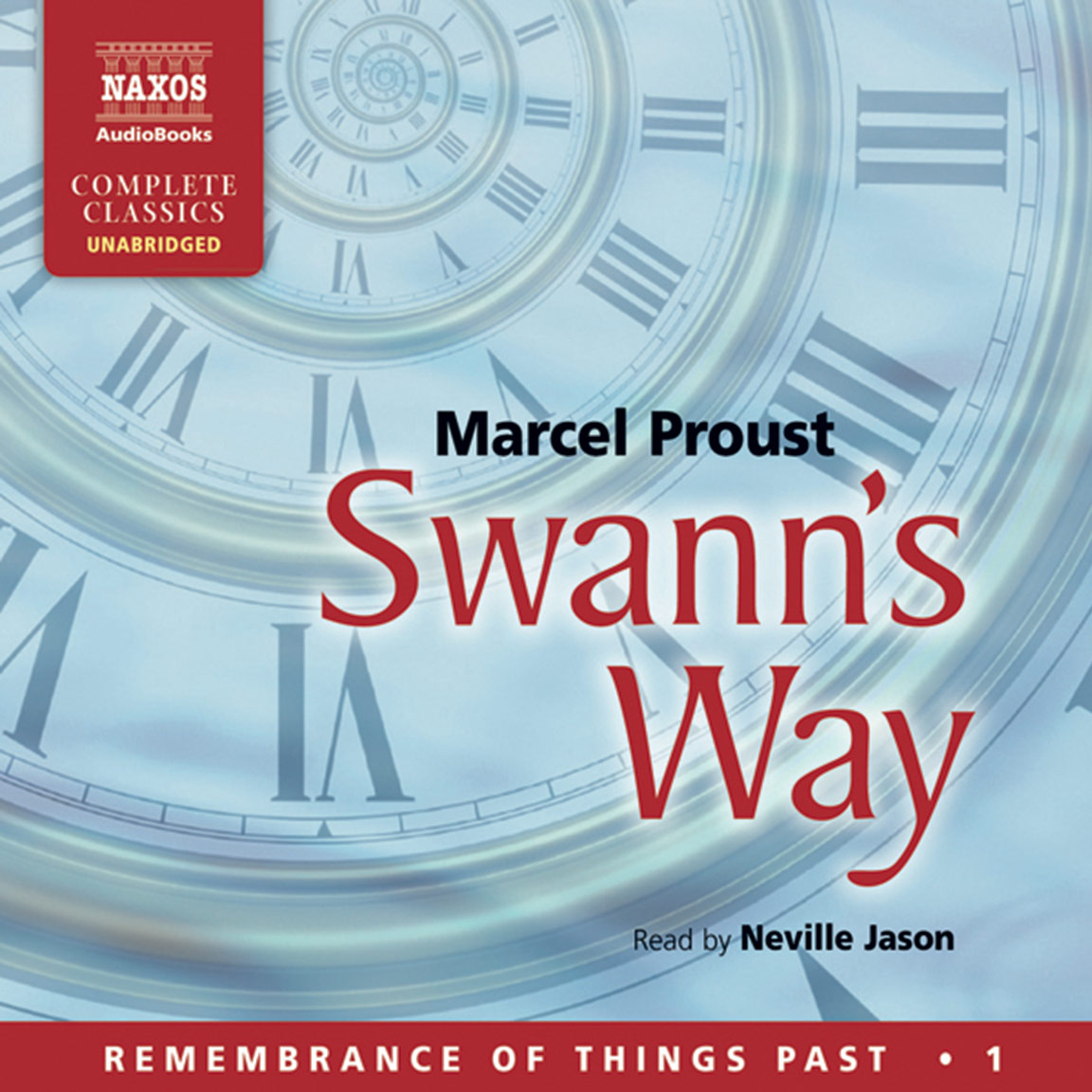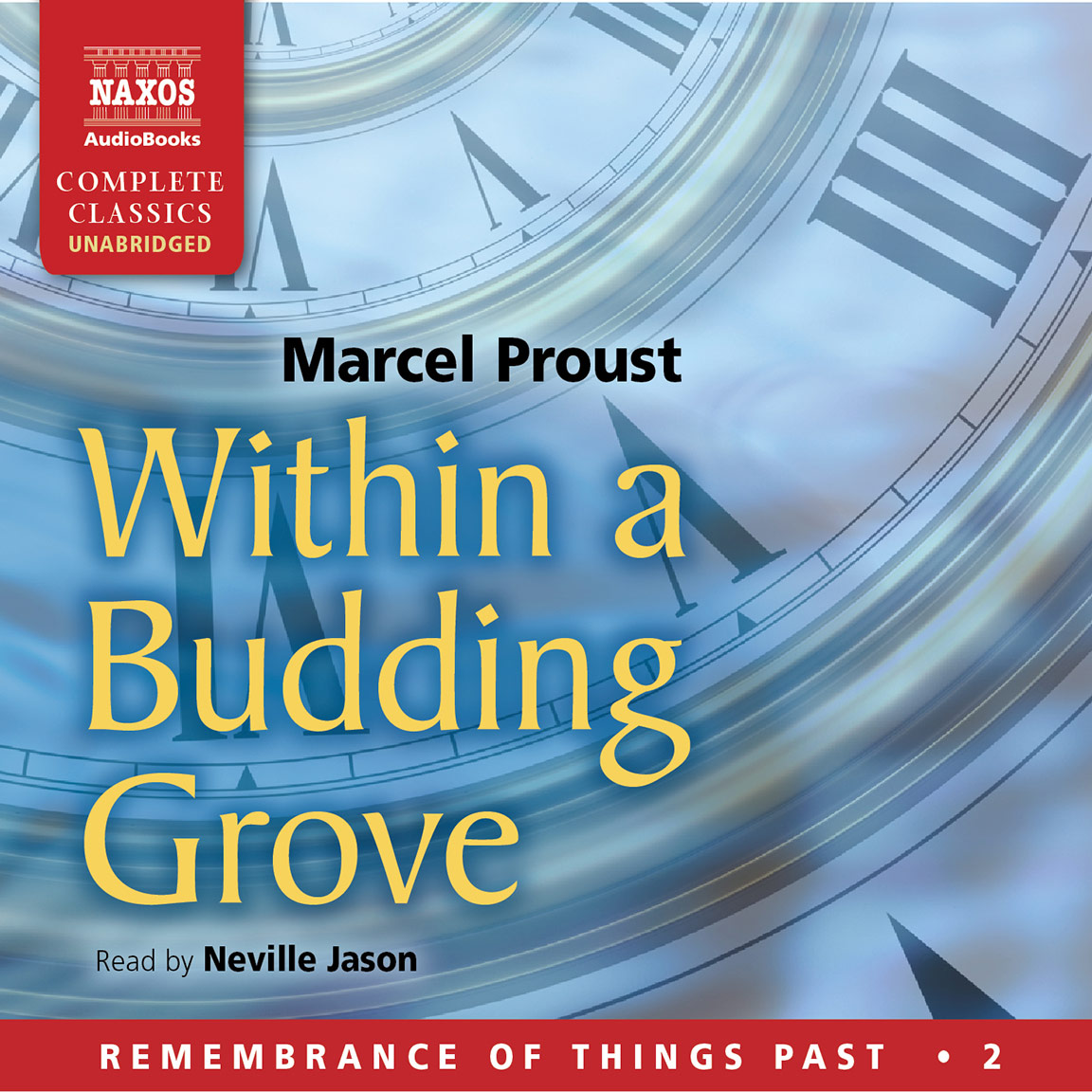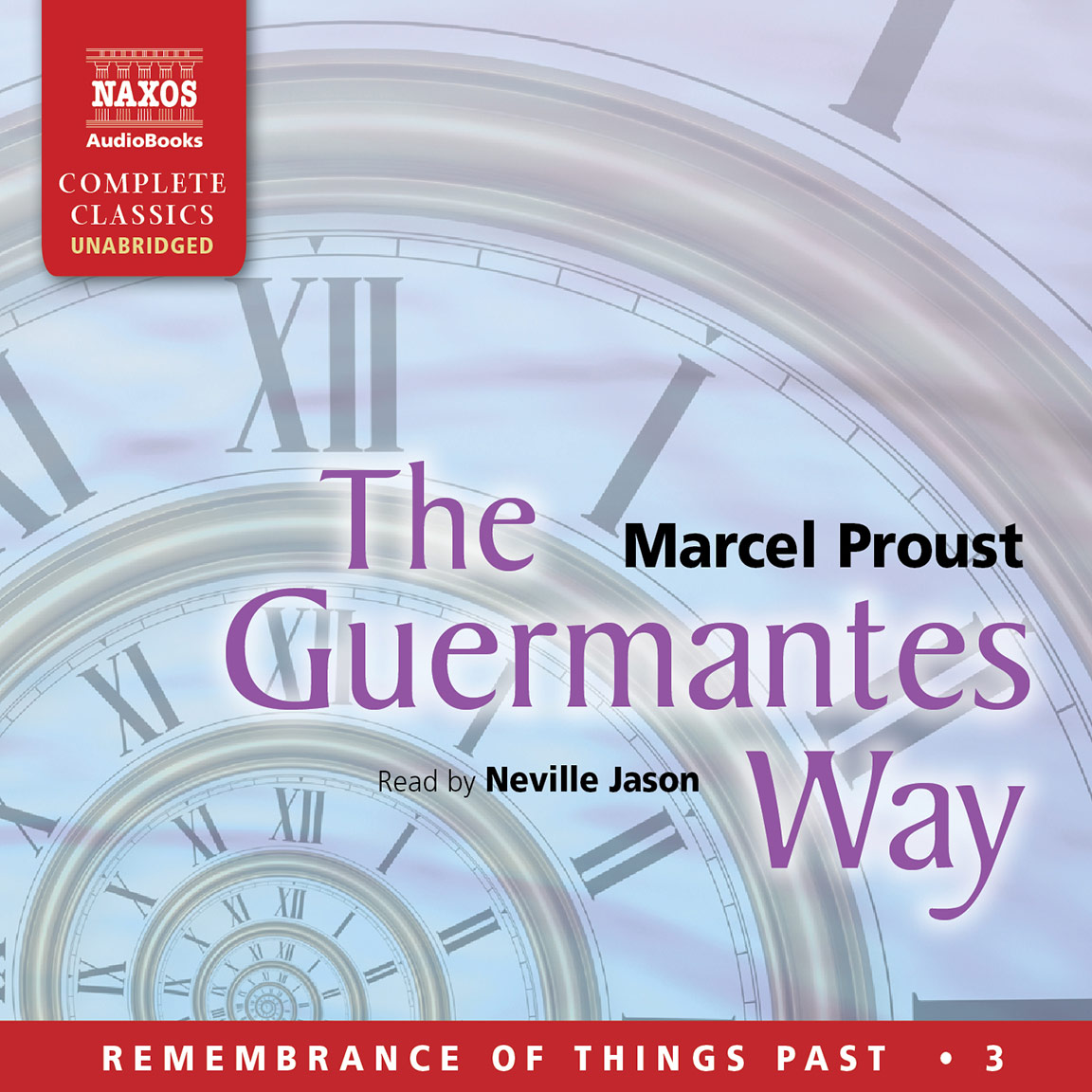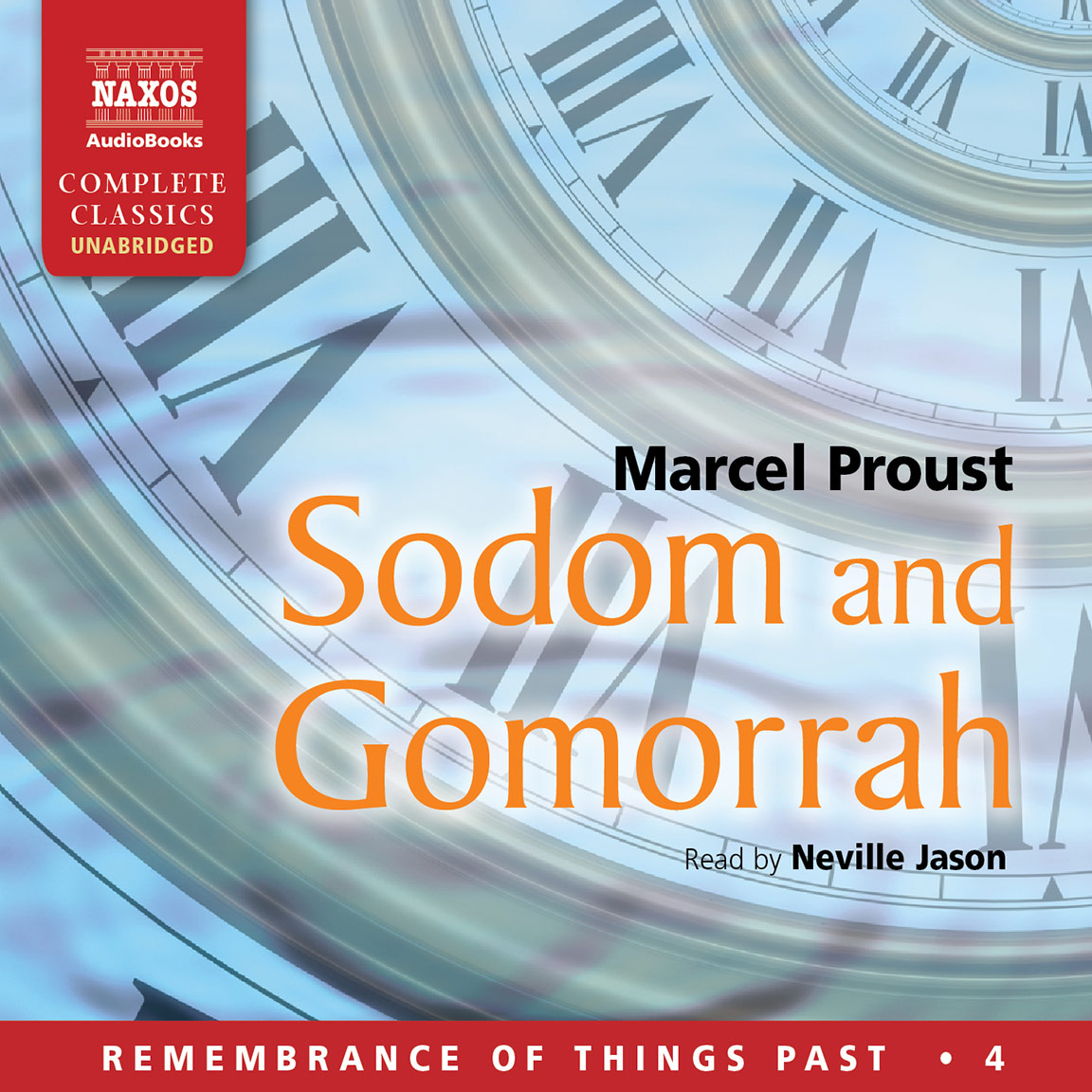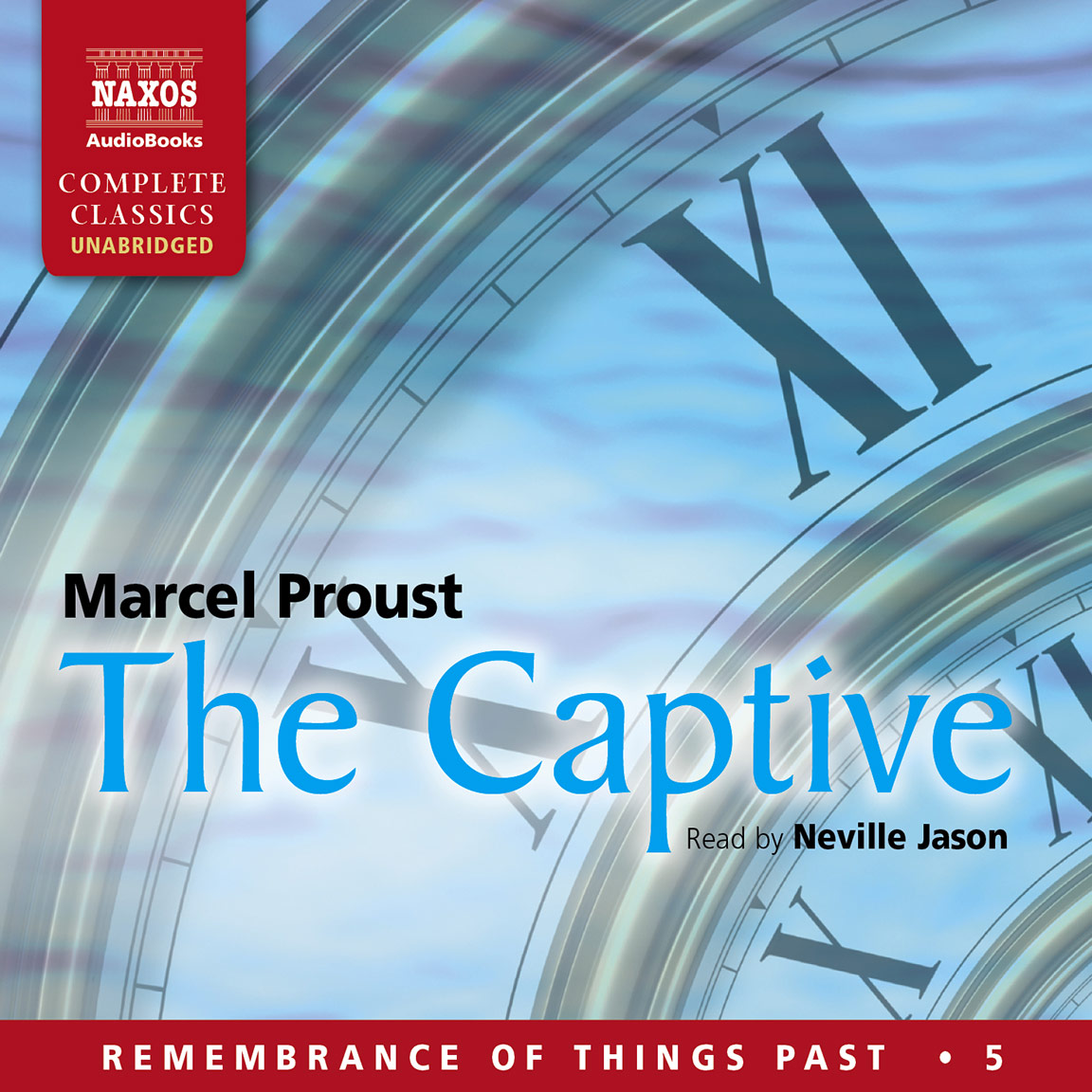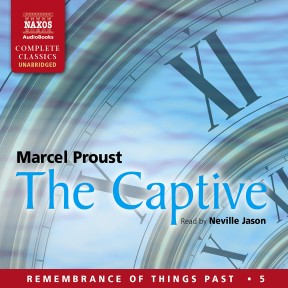
Audio Sample
Marcel Proust
The Captive
Read by Neville Jason
unabridged
Remembrance of Things Past is one of the monuments of 20th-century literature. Neville Jason’s unabridged recording of the work runs to 150 hours. The Captive is the fifth of seven volumes. The Narrator’s obsessive love for Albertine makes her virtually a captive in his Paris apartment. He suspects she may be attracted to her own sex. Based on the translation by C. K. Scott Moncrieff.
-
Running Time: 19 h 55 m
More product details
Digital ISBN: 978-1-84379-623-7 Cat. no.: NA0104 Download size: 570 MB Translated by: C. K. Scott Moncrieff BISAC: FIC000000 Released: September 2012 -
Listen to this title at Audible.com↗Buy on CD at Downpour.com↗Listen to this title at the Naxos Spoken Word Library↗
Due to copyright, this title is not currently available in your region.
You May Also Enjoy
Booklet Notes
The critic André Maurois described Proust’s Remembrance of Things Past as ‘one of the greatest works of the imagination of all time’.
The literal translation of the work’s French title, ‘In Search of Lost Time’, contains within it a clue to the creation of this monumental work of biographical fiction. Having wasted time living a dilettante existence in the fashionable world, Proust, in middle age, decided to re-dedicate his life to art, and to attempt at last to achieve the great work of which he knew himself capable.
Remembrance of Things Past was his chance to justify his life, and to cheat death through an act of artistic creation. It was the means he would use to conquer time through recreating his lost years. Memory was the material with which he would weave the magic cord to be launched into infinity; that cord which now binds us to him, and stretches forward into the future, linking his genius to unborn generations.
The Author
Marcel Proust was born on 10 July, 1871. His father, a distinguished professor of medicine, was from a Catholic family, while his mother was Jewish. Although convinced from an early age of his calling as a writer, Proust was riddled with self-doubt and wrote relatively little at the beginning of his career.
The death of his adored mother in 1905 resulted in a nervous collapse
During his twenties, he co-founded a short-lived review, Le Banquet; contributed to another literary publication, La Revue Blanche; and in 1896 had his first book published, a collection of essays entitled Les Plaisirs et Les Jours.
He became an enthusiastic admirer of Ruskin and translated his Bible of Amiens and Sesame and Lilies into French. A novel, Jean Santeuil, which was the precursor of Remembrance of Things Past, was abandoned, and eventually published long after Proust’s death, in 1954. For much of his youth Proust led the life of a man-about-town, frequenting fashionable Paris drawing rooms and literary salons, which were to form the background of a number of his early stories and sketches, and subsequently of Remembrance of Things Past.
The death of his adored mother in 1905 resulted in a nervous collapse and aggravated his chronic asthma and insomnia. But, despite his grief and the sense of loss, from which he never recovered, his mother’s death freed him with regard to his homosexual way of life, and allowed him to address same-sex love in his writing, albeit in a form which treated such experiences as happening to others rather than to himself.
In 1907 he moved into an apartment in the Boulevard Haussmann where, in the bedroom which he had had lined with cork to keep out noise, he embarked upon his great work À la Recherche du Temps Perdu (Remembrance of Things Past). In it the minuteness of his observation, the depth of his psychological understanding and the vividness of his descriptive powers combined to create one of the most poetic and magical works in all literature.
Publication of Remembrance of Things Past
This long autobiographical cycle was originally published in eight sections: Du Côté de Chez Swann (Swann’s Way) in 1913; A L’Ombre des Jeunes Filles en Fleurs (Within a Budding Grove) in 1918; Le Côté de Guermantes I (The Guermantes Way I) in 1920; Le Côté de Guermantes II and Sodom et Gomorrhe I (Cities of the Plain I) in 1921; Sodom et Gomorrhe II in 1922; La Prisonnière (The Captive) in 1923; Albertine Disparue (The Sweet Cheat Gone/The Fugitive) in 1925 and Le Temps Retrouvé (Time Regained) in 1927.
Proust was obliged to publish Swann’s Way at his own expense, and even after it had appeared, had trouble finding a publisher for the next part, A L’Ombre des Jeunes Filles en Fleurs. However, when it appeared in 1918 it received considerable acclaim, and was awarded the Prix Goncourt the following year.
By the time Proust died, on 18 November, 1922, the first four parts of the cycle had been published, leaving the others to appear posthumously.
The Captive – Part I
The Captive continues the story of the Narrator’s obsession with Albertine. Having re-established his friendship with her during his second visit to Balbec, he is tortured by fears regarding her sexual orientation. These fears have their origin in two incidents. The first is when Marcel, accompanied by Dr Cottard, watches Albertine and her friend Andrée dancing together in the Casino and the doctor remarks on the intimate way the two girls are holding each other with their breasts touching. Marcel is alerted to the possibility that Albertine might be attracted to members of her own sex. However, he is ready to believe that the idea is due to his overheated imagination until Albertine innocently mentions that her greatest friends were two older women, the daughter of the composer Vinteuil and her lesbian friend, whose private love-making Marcel has accidentally witnessed some years earlier at Combray.
Proust’s analysis of the pain caused by erotic love is unique
From this moment he is determined to keep Albertine from satisfying her desire for women by whatever means necessary, even if it entails marrying her. On the spur of the moment he decides to take her back to Paris with him where, in the absence of his parents, he installs her in his family’s apartment and lavishes on her expensive gifts of jewellery and dresses. Albertine revels in such unaccustomed luxury and in return tries to please him by granting him certain sexual favours. But Marcel’s jealous suspicions gradually turn her into a prisoner. He allows her to go nowhere without his permission, and gives the chauffeur he has engaged to drive her around Paris orders to keep constant watch on her. Although Albertine does not complain, Marcel is aware that by curtailing her freedom in this way he is making her more and more unhappy.
Marcel’s is a love which can never be satisfied; as long as he feels secure in his possession of Albertine he is bored; it is only when he fears she is escaping that he feels an overwhelming yearning for her. The moment he suspects her of deceiving him his passion instantly revives. Although her docile obedience has the effect of calming his fears, Albertine is given to lying to him, and each time he catches her out, his anguish returns. He realises that even stronger than his wish to enjoy her himself, is his determination to prevent her from being enjoyed by another.
Proust’s analysis of the pain caused by erotic love is unique. Not only does he display the observation of a scientist and the language of a poet, but his insight is that of a psychologist. In linking the Narrator’s desire for Albertine’s nightly caresses with his need for the benediction of his mother’s goodnight kiss, Proust’s understanding of the psychological phenomenon of a continuing Oedipal struggle is clearly demonstrated. Marcel’s wish-fantasy of gaining complete possession of his mother’s love by interposing himself between her and his father is replayed again and again as he attempts to secure the undivided affection of Albertine in separating her from possible rivals.
In Remembrance of Things Past, the line between fact and fiction is fine indeed. Although Proust publicly denied that he and the Narrator were the same person, in The Captive, for the first time anywhere in the work, he teasingly lets slip the Narrator’s name, which we are hardly surprised to learn is ‘Marcel’. Nowhere in the narrative is it more evident that the author is speaking from the depths of his own experience when he observes in the words of the Narrator:
Jealousy, which wears a bandage over the eyes, is not merely powerless to discover anything in the darkness which enshrouds it, it is also one of those torments where the task must be incessantly repeated, like that of the Danaïdes or Ixion.
The Captive – Part II
Marcel, accompanied by the pedantic Brichot, attends a musical evening at the Verdurins’. Marcel has decided to keep his visit a secret from Albertine, because a previously unpublished work by Vinteuil is to be played, and he has heard that the composer’s daughter Mlle Vinteuil and her friend are to be present. Marcel knows them to be a lesbian couple, and the revelation by Albertine of her long-standing friendship with them has confirmed his suspicions regarding Albertine’s sexual proclivities. He is determined to keep Albertine from having any contact with the two women.
In the event, Mlle Vinteuil and her friend fail to appear. The music is a revelation to Marcel, and he is astonished to learn that it has been patiently pieced together from Vinteuil’s notes after his death by the one person capable of doing so: his daughter’s friend. Thus the person who caused Vinteuil the greatest anguish during his lifetime has done him the greatest service after his death. Marcel realises that even the sadistic scene he witnessed many years earlier, in which Vinteuil’s daughter and her friend desecrated the composer’s photograph, was born out of their love and respect for him, which in the end triumphed over their perversity.
Marcel is torn between boredom with Albertine’s presence, and fear of her absence
The concert at the Verdurins’ house has been arranged by the Baron de Charlus, in order to promote the career of his protégé, the violinist Charles Morel. Over time Charlus has ceased to worry about hiding his homosexuality; he openly flirts with the Verdurins’ footman, and proudly displays his intimacy with Morel, the star performer of the evening. Due to his position in the aristocratic circle of the Faubourg St Germain, he has managed to attract members of the highest society for the occasion. But Charlus has already offended Mme Verdurin by his high-handed manner in dictating to her whom she may and may not invite, and his offence is further compounded when he fails to introduce her to the grand friends who come up to greet him. Furious, she decides to punish Charlus by destroying his friendship with Morel. She tells the violinist that the nature of his friendship with Charlus is public knowledge and is ruining his career. Morel is taken in by her story, and decides that his best course of action is to repudiate Charlus publicly. When he does so, Marcel is amazed to see Charlus, the scourge of countless others who have dared to attack him, unable to respond. He is so devastated by the unexpected turn of events that he is rendered quite speechless. But before Mme Verdurin has time to enjoy his discomfiture to the full, the Queen of Naples, who has overheard the scene, intervenes to rescue Charlus. Whatever she thinks of the Baron, he is ‘one of her own’, and we witness the nobility protecting the aristocracy from an attack by the bourgeoisie.
But despite the perfidy and heartlessness of the Verdurins (we have earlier seen Mme Verdurin boasting that she felt nothing on learning of the death of her friend the Princess Sherbatoff), the author is not satisfied to leave us with such a simplistic picture. He follows this scene with an account of how the Verdurins, on hearing that Saniette, the habitual object of their public displays of cruelty, has ruined himself through gambling, instantly plan a means of rescuing him financially. Time and again in the novel we are taken by surprise as Proust shows us yet another example of the complexity of human nature. It is as if, knowing the impulse for both good and evil which lie within his own personality, Proust invests his characters with similarly opposing natures, warning us that people are never quite what they seem.
On returning home, Marcel admits to Albertine that he has been to the Verdurins’. She becomes incensed when he attempts to draw her out on the subject of Mlle Vinteuil and her friend. Marcel’s pretence of knowing more about Albertine than he actually does leads to her revealing several lies he had never suspected, and admitting to a closer acquaintance with certain women of doubtful reputation than he had hitherto guessed. When he accuses Albertine of having relations with Andrée, she becomes furious, and it is all he can do to calm her. Eventually they are reconciled, but from this time on, in a poignant reminder of his childhood experience with his mother, Albertine refuses to grant him his goodnight kiss.
In an attempt to win back Albertine’s affection, Marcel plies her with gifts, ordering magnificent Fortuny dresses, and taking her for trips by automobile. On one outing they witness an aeroplane flying high in the sky, a metaphor for the freedom for which Albertine yearns. Marcel is torn between boredom with Albertine’s presence, and fear of her absence. He longs to travel to Venice or to meet other women, but the thought of leaving her alone to indulge her desire for women terrifies him. One morning he awakes to be informed by Françoise that Albertine has taken her luggage and left; the Captive has flown.
Proust’s novel is, of course, auto-biographical. Despite his denials, the narrative broadly follows the story of his own life, given that events are altered and transposed and characters are often the amalgam of several different real-life people. But although the events of Proust’s life form the basis of the novel’s narrative, they are no more than the structure around which he builds his astonishingly imaginative and original edifice; the facts are no more important than the bricks used to build a cathedral, and real life for Proust is merely the raw material of artistic creation.
That said, Proust was an intriguing and extraordinary figure, and has been the subject of much biographical speculation. Although he was a very private person who spent much of his life alone, he was a prolific letter writer, and we learn a great deal about him from the vast correspondence which has gradually surfaced over the years since his death. Despite being a chronic invalid, Proust was outgoing and gregarious when he felt well, and in his youth could be extremely social. The accounts of his friends paint a picture of an exceptionally witty and amusing companion, capable of great acts of kindness and generosity.
Although he fell in love in his own fashion with certain women, Proust admitted privately that his sexual relationships had been only with men, and it seems clear that in recreating his experiences in fictional form he transformed his homosexual relationships into heterosexual ones, and his male lovers into women.
It is likely that there were several originals of Albertine, although the most important one appears to have been his chauffeur Alfred Agostinelli, who Proust described as ‘a young man whom I loved probably more than all my friends’. There were several ‘captives’ as well, young men hired as ‘secretaries’ who lived in Proust’s apartment and occupied the room next to his. Certainly the great tragedy of his emotional life – that he was only able to love what he could not have – was implicit in his relationships with young, basically heterosexual men. Marcel’s love for Albertine is conditional on her availability. As long as he fears she might escape from him, Marcel cannot part with her. Once he feels he possesses her, he becomes bored and wishes to escape. Proust has described this dilemma with such vivid insight that there can be little doubt that The Captive was wrought out of the author’s own deep and painful personal experience.
The Life and Work of Marcel Proust
To avoid any confusion, it may be helpful to point out that Proust’s great work, À La Recherche du Temps Perdu, was originally translated into English by Charles K. Scott-Moncrieff and published in 1922 under the title, Remembrance of Things Past. It was subsequently re-translated by Terence Kilmartin and appeared in 1981 as In Search of Lost Time. In 2002 a new edition appeared under the same title, with each volume assigned to a different translator. The Naxos AudioBooks recordings use the Scott-Moncrieff text and, in references to the work, I use Scott-Moncrieff’s title.
My own contact with Proust began when, as a 17-year-old schoolboy, I first read Swann’s Way. I could not have guessed then that, many years into the future, Proust would take over my life to such an extent. Over a six year period during the 1990s, I abridged and recorded Remembrance of Things Past for Naxos Audiobooks, for whom I have now recorded this entire, uncut text.
 When I was asked to write The Life and Work of Marcel Proust, it occurred to me that, although the people on whom Proust based his characters were no longer living, the places he wrote about were still there, and so I travelled to France to see them.
When I was asked to write The Life and Work of Marcel Proust, it occurred to me that, although the people on whom Proust based his characters were no longer living, the places he wrote about were still there, and so I travelled to France to see them.
I was delighted to discover that Illiers, where Marcel Proust spent his holidays as a child, and which figures in the book as Combray, is now marked on maps and road signs as Illiers-Combray, in official recognition of the reason for this sleepy village’s wider fame.
In a narrow street just off the market square in Illiers-Combray is the house in which Proust’s father, Adrien Proust, was born, and further along is the house of his aunt Élisabeth, now a Proust museum, where Élisabeth’s fictional counterpart, the bedridden Aunt Léonie, watched the world go by from her bedroom window. Around the corner from the house is a little boulangerie with a sign in the window announcing proudly: ‘This is where Aunt Léonie bought her madeleines’. It only occurs to me as I buy a packet of the scallop-shaped cakes, that Aunt Léonie is a creature of fiction. Never mind, Aunt Élisabeth might well have patronised the establishment, or one very like it. Up the hill there is a real house called Tansonville, the name of the house occupied by Charles Swann, and later by his daughter Gilberte and her husband Robert de Saint-Loup, and further on there is a real village called Méréglise, a name almost identical to the fictional Méséglise.
Water lilies are still reflected in the glassy surface of the river Loir, which in the book bears the more poetic name the Vivonne, and beyond the stream lies the Pré Catalan, the enchanting park created by Proust’s horticulturally minded Uncle Jules. From Illiers I travelled on to Cabourg, a seaside resort on the Normandy coast, the original of the fictional Balbec. Here I found the Grand Hotel in all its Edwardian splendour. It was rebuilt after Proust spent holidays there as a child, but he returned as an adult, and sections of Remembrance of Things Past were written beneath its roof. As in Within a Budding Grove, the great glass windows of the restaurant look out over the promenade to the beach below, and with a little imagination, that group of budding young girls in bikinis is transformed into the little band of ‘jeunes filles en fleurs’ outlined against the sea.
I travelled on to Paris, visiting 102 Boulevard Haussmann, Proust’s home for many years, where he wrote so much of Remembrance of Things Past. The building is still owned by the same bank that purchased it from Proust’s aunt, when her inconsiderate decision to sell it forced him to move. His bedroom is still there, but unfurnished, and to see the room as it was, one is obliged to visit the Musée Carnavalet, where his bed, chaise-longue and other effects are displayed in a reconstruction of the famous cork-lined room.
A walk to the gardens of the Champs Élysées brought me to an area with a sign announcing that I am in the Allée Marcel Proust. Children chase each other – perhaps playing the modern equivalent of ‘prisoners base’, the game played by Gilberte and her friends. This is where the real Marcel played as a child with the real Marie de Benardaky, with whom he fell in love, just as the fictional Marcel falls in love with the fictional Gilberte Swann.
In the real world the same spaces are occupied now by different people. Time has moved on, but places remain, and we have the privilege of being present in not only the imaginary world Proust created, but that portion of the real world which had a part in its creation. His presence has left behind a trace of magic, and we see places differently, because we see them through his eyes. One day those places will have crumbled into dust, as will we ourselves, and the space we now consider ours will be occupied by others. But as long as civilisation remains, those who come after us will be able to share Proust’s vision and enter his world. Proust was aware that art is the only true reality, and that through his creations the artist continues to live after his death, beyond space and beyond time.
Notes by Neville Jason

